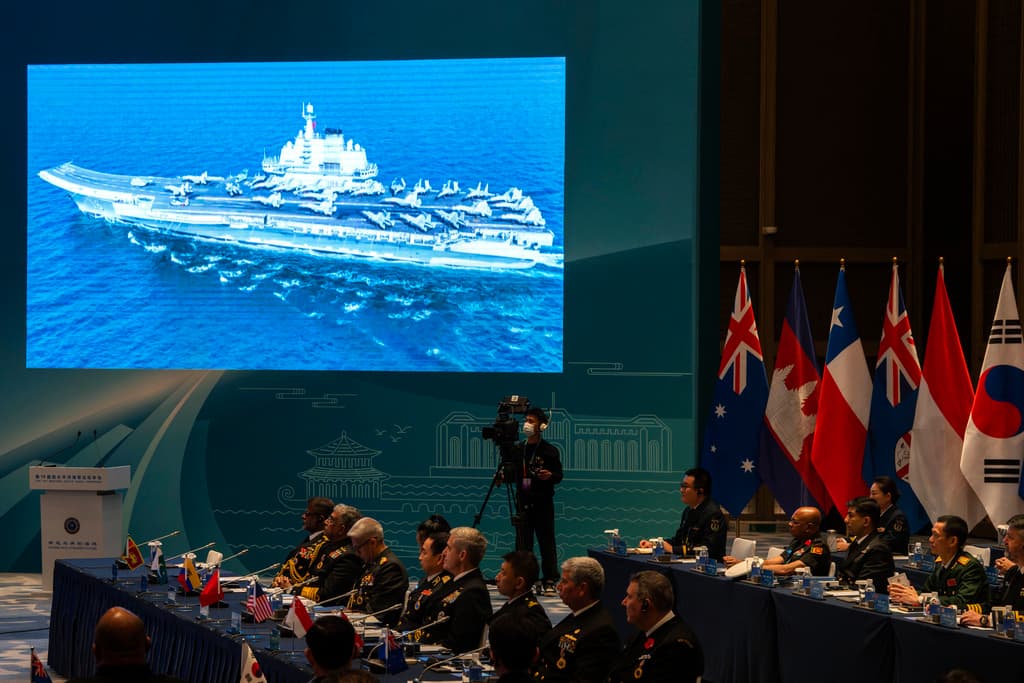Communist China Said To Be Constructing a First-of-Its-Kind Ship That Could Launch Aerial Drones
China ‘could win a war quite easily and even destroy the United States in that war,’ one foreign policy hawk says.

The People’s Liberation Army Navy could be building the world’s first-ever dedicated “drone carrier,” a new innovation to bolster its expanding naval fleet while the American Navy struggles to keep pace.
New satellite images from a Chinese shipyard showcase a vessel with a flight deck lower than that of traditional aircraft carriers and “wide enough to comfortably operate aircraft or drones,” according to Naval News and a senior resident fellow at the Mitchell Institute for Aerospace Studies, J. Michael Dahm, who analyzed the images. Besides its runway, the ship, which is one-third the length and half the width of a U.S. Navy or Chinese Navy supercarrier, “is unusual in every respect.”
It is unclear whether the ship is part of a commercial project or an official naval program, according to the analysis. It is also unclear what kinds of unmanned aerial vehicles Communist China could operate from the vessel. From the same shipyard hidden far upriver on the Yangtze, China has already built two drone mini-carriers, which seem to be used to stimulate hostile drone swarms and train forces against other unmanned threats.
The news comes as Beijing doubles down on its investment to dominate the seas and even to colonize the moon. Bolstered by its shipbuilding manufacturing industry, China now has the world’s largest naval fleet, with roughly 370 warships and counting. The U.S. Navy, meanwhile, has some 280 ships, and future production is set to be strained by delays and budget cuts.
“Although we’re a far stronger society than China, they could win a war quite easily and even destroy the United States in that war,” the author of a 2023 book, “China Is Going To War,” Gordon Chang, tells the Sun. As it relates to the balance of military power, “the most concerning thing is not China. It’s us. In the face of obvious threats, we are not preparing with the vigor that is necessary. We don’t have the determination. We don’t have the political will.”
President Biden has asked the Navy to take a 3 percent cut, accounting for inflation, compared to the 2023 fiscal year. He proposed just a 1 percent increase in America’s overall defense and national security budget as part of his $895 billion request in March. Now, the Navy is asking in its budget request of $268 million for the 2025 fiscal year to retire 19 battle force ships and produce only six, while cutting personnel, weapons, and military construction.
Compare that to America’s chief military competitor. Beijing began sea trials this month on its third and most powerful aircraft carrier, the Fujian. At 300 meters long and 80,000 tons, she does not outshine America’s biggest carrier, the USS Gerald R. Ford. Yet she could be the first ship outside American carriers and France’s Charles de Gaulle to have catapults, which would allow her to launch jets fully armed and fueled for combat.
“We have a quantum leap that we need to make. And we need to do it soon,” Senator Wicker said last week at a hearing on Naval and Marine shipbuilding convened by the Senate Armed Services Committee. “The truth is that our naval fleet is too small and too old to meet the demands of our combatant commanders and our National Defense Strategy, particularly in the years going forward.”
The issues are not stemming from an underperforming industry, Mr. Wicker warned, but from mismanagement. In a rare show of honesty, a Naval review ordered by its secretary, Carlos Del Toro, disclosed a cumulative delay of more than 11 years for nine shipbuilding programs. After the report came out last month, the Navy’s senior acquisition executive, Nickolas Guertin, told reporters, “we are identifying and deeply looking into where we are now in a ‘get real, get better’ approach.”
The Navy and industry leaders have pointed to the linger effects of the Covid pandemic on America’s industrial base and underlying supply chain. A crisis in recruiting could also be to blame. Mr. Wicker said that a shrinking workforce has prompted the Navy to lower standards and sacrifice quality, citing reports that the Navy could miss its recruiting mission by nearly 15 percent this year.
While naval innovations might be slowing down at home, other nations are stepping up to the plate. In addition to China, Iran and Turkey are exploring designs for drone carriers. On Monday, it was a drone manufactured by the Turkish defense company Baykar that successfully discovered the helicopter that crashed over the weekend, killing Iran’s president and foreign minister. The aerial vehicle subsequently drew a star and a crescent in its flight pattern.
America might have lost the clear lead it enjoyed on the seas after World War II, yet it has a chance to catch up. Last month, the U.S. Navy began construction on a new kind of warship — the USS Constellation (FFG-62) — at a new facility in Fincantieri Marinette Marine in Wisconsin through a Navy contract for ten ships announced in 2020 that could be worth more than $5.5 billion.
The Navy’s 2025 shipbuilding budget includes a proposal for the Medium Landing Ship program, a class of 18 to 35 new amphibious ships that would support the Marine Corps in a potential confrontation with China in the Western Pacific. The ships would each be smaller and less expensive to build and operate than the Navy’s current amphibious ships, with the first in the class ready to hit the seas by 2029.
“This new program can apply lessons learned,” Mr. Wicker told lawmakers, “to ensure that the Marines get a ship at the capacity and schedule they need for campaigning in the Pacific.”

